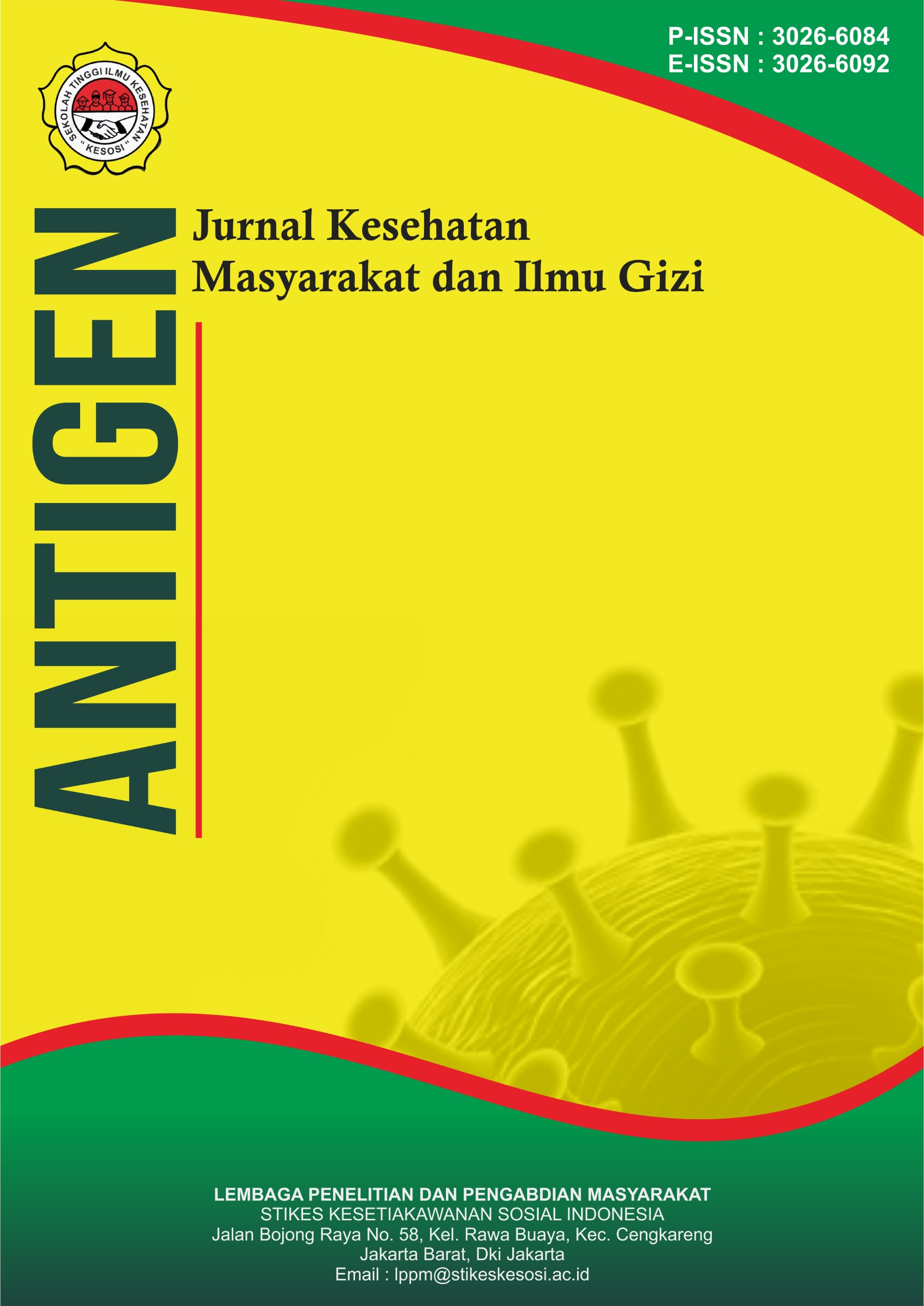Pengaruh Penggunaan Terapi Antosianin terhadap Penyakit Alzheimer : Literature Review
DOI:
https://doi.org/10.57213/antigen.v3i3.741Keywords:
Alzheimer’s Disease, Anthocyanins, Neurodegeneration, Oxidative Stress, Β-AmyloidAbstract
Alzheimer’s disease is the most common form of neurodegenerative disorder, characterized by cognitive decline, β-amyloid plaque accumulation, and oxidative stress in brain tissue. One promising alternative therapy is the use of anthocyanins, flavonoid compounds found in various red, purple, and blue-colored plants. This study aims to review the effectiveness of anthocyanins in preventing and slowing the progression of Alzheimer’s disease through a literature review. Articles published between 2014 and 2024 were selected from PubMed, Scopus, and Google Scholar databases, with inclusion criteria focusing on preclinical animal studies evaluating the effects of anthocyanins on neurodegenerative markers. The results show that anthocyanins, particularly pelargonidin and delphinidin, play a role in improving memory, reducing oxidative stress, and inhibiting β-amyloid plaque formation in animal models. Anthocyanins also enhance antioxidant enzyme activity and reduce neuronal apoptosis. These findings support the potential of anthocyanins as neuroprotective agents in Alzheimer’s therapy, although further clinical research is required to validate their efficacy in humans.
References
Agnihotri, A., & Aruoma, O. I. (2020). Alzheimer’s disease and Parkinson’s disease: A nutritional toxicology perspective of the impact of oxidative stress, mitochondrial dysfunction, nutrigenomics and environmental chemicals. Journal of the American College of Nutrition, 39(1), 16–27. https://doi.org/10.1080/07315724.2019.1683379
Alzheimer’s Association. (2021). 2021 Alzheimer’s disease facts and figures. Alzheimer’s and Dementia, 17(3), 327–406. https://doi.org/10.1002/alz.12328
Apriali, K. D., & Nur’aini, Y. A. (2022). Studi penambatan molekul dan prediksi ADMET senyawa metabolit sekunder tanaman kelor (Moringa oleifera L.) sebagai inhibitor BACE1 pada penyakit Alzheimer. Fitofarmaka: Jurnal Ilmiah Farmasi, 12(1), 58–67. https://doi.org/10.33751/jf.v12i1.4351
Chozinnia, V. (2022). Kajian aktivitas antioksidan ekstrak beras ketan hitam (Oryza sativa Linn. var. glutinosa) [Skripsi atau artikel – perlu diperjelas].
El-Shiekh, R. A., & Abdel-Sattar, E. (2020). Hibiscus sabdariffa L.: A potent natural neuroprotective agent for the prevention of streptozotocin-induced Alzheimer’s disease in mice. Biomedicine and Pharmacotherapy, 128, 110303. https://doi.org/10.1016/j.biopha.2020.110303
Heysieattalab, S., & Sadeghi, L. (2020). Effects of delphinidin on pathophysiological signs of nucleus basalis of Meynert lesioned rats as animal model of Alzheimer disease. Neurochemical Research, 45(7), 1636–1646. https://doi.org/10.1007/s11064-020-03027-w
Hidayatul, N., & Sinuraya, R. K. (2016). Biomarker miRNA-146a sebagai deteksi dini yang efektif untuk Alzheimer. Farmaka, 15(2), 159–177.
Ifadah, R. A., & Afgani, C. A. (2022). Ulasan ilmiah: Antosianin dan manfaatnya untuk kesehatan. Jurnal Teknologi Pengolahan Pertanian, 3(2), 11–21. https://doi.org/10.35308/jtpp.v3i2.4450
Irene, E. (2015). Uji toksisitas subkronik antosianin ubi jalar (Ipomoea batatas L.) varietas ungu kultivar Gunung Kawi terhadap histopatologi ginjal tikus Rattus norvegicus strain Wistar yang dipapar diet normal [Skripsi atau tesis – perlu diperjelas].
Kovács, Z., & Veres, A. (2017). Characteristics and regulation of anthocyanin biosynthesis in pepper: A review. Columella: Journal of Agricultural and Environmental Sciences, 4(1), 47–58. https://doi.org/10.18380/szie.colum.2017.4.1.47
Kunnaryo, H. J. B., & Wikandari, P. R. (2021). Antosianin dalam produksi fermentasi dan perannya sebagai antioksidan. Unesa Journal of Chemistry, 10(1), 24–36. https://doi.org/10.26740/ujc.v10n1.p24-36
Kurniasari, N. P. L., & Dewi, W. (2022). Kajian literatur: Potensi Clitoria ternatea sebagai upaya terapi preventif penyakit Alzheimer. Jurnal Jejaring Matematika dan Sains, 4(1), 1–5. https://doi.org/10.36873/jjms.2022.v4.i1.701
Liu, F., & Bi, Y. (2018). A comparative transcriptome analysis of a wild purple potato and its red mutant provides insight into the mechanism of anthocyanin transformation. PLoS ONE, 13(1), e0191406. https://doi.org/10.1371/journal.pone.0191406
Sohanaki, H., & Roghani, M. (2016a). Pelargonidin improves memory deficit in amyloid β25–35 rat model of Alzheimer’s disease by inhibition of glial activation, cholinesterase, and oxidative stress. Biomedicine and Pharmacotherapy, 83, 85–91. https://doi.org/10.1016/j.biopha.2016.06.021
Sohanaki, H., & Roghani, M. (2016b). Pelargonidin improves passive avoidance task performance in a rat amyloid β25–35 model of Alzheimer’s disease via estrogen receptor-independent pathways. Acta Medica Iranica, 54(4), 245–250.
Soleimani Asl, S., & Mehdizadeh, M. (2019). Pelargonidin improves amyloid β-induced deficits in the long-term potentiation in hippocampus of male rats. Physiology and Pharmacology (Iran), 23(4), 296–301.
Suresh, S., & V, C. (2022). Anthocyanin as a therapeutic in Alzheimer’s disease: A systematic review of preclinical evidences. Ageing Research Reviews, 76, 101595. https://doi.org/10.1016/j.arr.2022.101595
Tikhonova, M. A., & Khlestkina, E. K. (2020). Evaluating the effects of grain of isogenic wheat lines differing in the content of anthocyanins in mouse models of neurodegenerative disorders. Nutrients, 12(12), 1–21. https://doi.org/10.3390/nu12123877
Tjandra Dewi, V., & Laksmidewi, A. A. A. P. (2023). Manifestasi klinis dan gambaran pencitraan struktural dan fungsional berbagai subtipe demensia. Cermin Dunia Kedokteran, 50(11), 594–599. https://doi.org/10.55175/cdk.v50i11.836
Widayani, S. T., & Atmaka, D. R. (2025). Dampak positif fitokimia antosianin terhadap risiko penyakit kardiovaskular: Literature review. [Nama jurnal tidak dicantumkan], 6, 2769–2778.
World Health Organization. (2017). Global action plan on the public health response to dementia 2017–2025. World Health Organization. http://www.who.int/mental_health/neurology/dementia/action_plan_2017_2025/
Downloads
Published
Issue
Section
License
Copyright (c) 2025 Antigen : Jurnal Kesehatan Masyarakat dan Ilmu Gizi

This work is licensed under a Creative Commons Attribution-ShareAlike 4.0 International License.






